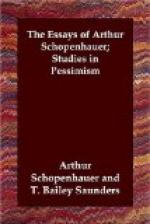and that, too, in public.[3] And in ancient times,
how many heroes and wise men died a voluntary death.
Aristotle,[4] it is true, declared suicide to be an
offence against the State, although not against the
person; but in Stobaeus’ exposition of the Peripatetic
philosophy there is the following remark: The
good man should flee life when his misfortunes become
too great; the bad man, also, when he is too prosperous.
And similarly: So he will marry and beget
children and take part in the affairs of the State,
and, generally, practice virtue and continue to live;
and then, again, if need be, and at any time necessity
compels him, he will depart to his place of refuge
in the tomb.[5] And we find that the Stoics actually
praised suicide as a noble and heroic action, as hundreds
of passages show; above all in the works of Seneca,
who expresses the strongest approval of it. As
is well known, the Hindoos look upon suicide as a religious
act, especially when it takes the form of self-immolation
by widows; but also when it consists in casting oneself
under the wheels of the chariot of the god at Juggernaut,
or being eaten by crocodiles in the Ganges, or being
drowned in the holy tanks in the temples, and so on.
The same thing occurs on the stage—that
mirror of life. For example, in L’Orphelin
de la Chine[6] a celebrated Chinese play, almost
all the noble characters end by suicide; without the
slightest hint anywhere, or any impression being produced
on the spectator, that they are committing a crime.
And in our own theatre it is much the same—Palmira,
for instance, in Mahomet, or Mortimer in Maria
Stuart, Othello, Countess Terzky.[7] Is Hamlet’s
monologue the meditation of a criminal? He merely
declares that if we had any certainty of being annihilated
by it, death would be infinitely preferable to the
world as it is. But there lies the rub!
[Footnote 1: Hist. Nat. Lib. xxviii., 1.]
[Footnote 2: Loc. cit. Lib. ii. c. 7.]
[Footnote 3: 3 Valerius Maximus; hist. Lib. ii., c. 6, sec. 7 et 8. Heraclides Ponticus; fragmenta de rebus publicis, ix. Aeliani variae historiae, iii., 37. Strabo; Lib. x., c. 5, 6.]
[Footnote 4: Eth. Nichom., v. 15.]
[Footnote 5: Stobaeus. Ecl. Eth.. ii., c. 7, pp. 286, 312]
[Footnote 6: Traduit par St. Julien, 1834.]
[Footnote 7: Translator’s Note.—Palmira: a female slave in Goethe’s play of Mahomet. Mortimer: a would-be lover and rescuer of Mary in Schiller’s Maria Stuart. Countess Terzky: a leading character in Schiller’s Wallenstein’s Tod.]




